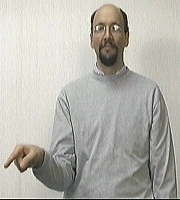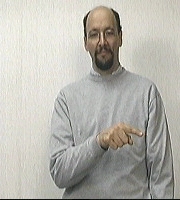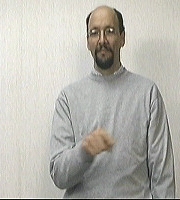American Sign Language: "indexing" or "pointing"
In ASL signs such as "he / she / it / me / you / them / those / that" are often expressed simply by pointing or what we call "indexing."
Perhaps the most simple and easy to understand "INDEX" type sign is the sign YOU.
YOU:

If you use a sweeping movement, the sign YOU can mean "all of you." Or if you live in the south it can mean "Y'all." (heh)
YOU-plural ("Y'all")
You can add facial expressions to inflect the meaning of this sign. Suppose you wanted to sign something like: "Humph, it's you?", "Is it you?", "Are you ... ?", "Did you?"
Such questions can be done with just one sign by adding the corresponding facial expressions:
YOU?!?

The ASL version of "WE" uses an index finger. If you see it done with a "W" it has been initialized and is considered Signed English and not ASL.
WE:
THEY/them:
Use a smooth sweeping movement off to the side:
Those-three:
Hold a 3-hand out a bit from your body (palm up) and circle it a couple times. Do this sign pointing toward the 3 people that you are referencing -- if they are visible. If the 3 people are not around then just do this sign off to your dominant side.
THESE

DISCUSSION:In a message dated 11/27/2006 9:35:59 PM Pacific Standard Time, roypugh@___________.edu writes:
Dr. Vicars,
The sign for "he" or "she" is simple; you just point to who you are talking about. But what if you are talking about someone who isn't in the room?
Example: Someone has just left the room.
Me: Who was he?
In that sentence, how do I sign "he?"
And one more quick question. How do I show possession with pronouns such as: yours, his, hers, mine, their's, etc?
I appreciate you taking the time to read this and your work on the website.
Sincerely,
Nathan Pugh
Dear Nathan,
In your first example: (Someone has just left the room.) "Who was he?" - The concept of "he" would be signed by pointing toward the door through which "he" exited or even at the chair which he recently vacated.
Your second question: How do I show possession with pronouns such as: yours, his, hers, mine, theirs, etc.?
Answer: You point your palm toward the referent. For example: "YOUR or YOURS" is indicated by pointing your palm at a person. The sign looks similar to that of a police officer signing "stop" while directing traffic.
To sign HIS/HERS/ITS you would do the same sign except you would do it off to the side.
The sign THEIRS if referring to a specific group would be signed the same as HIS/HERS/ITS.
The sign THEIRS if referring to two or more separate individuals would use the same handshape and palm orientation but the movement would start slightly off to the side and then sweep further to the side. The "sweeping" movement would add plurality to the sign.
Have a nice day.
Cordially,
Dr. Vicars
Also see: Indexing discussion page
Also see: THAT
You can learn
sign language
(ASL) online at American Sign Language University ™
Lifeprint.com © Dr. William Vicars













